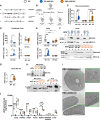Red Blood Cell and Endothelial eNOS Independently Regulate Circulating Nitric Oxide Metabolites and Blood Pressure
- PMID: 34229449
- PMCID: PMC8529898
- DOI: 10.1161/CIRCULATIONAHA.120.049606
Red Blood Cell and Endothelial eNOS Independently Regulate Circulating Nitric Oxide Metabolites and Blood Pressure
Abstract
Background: Current paradigms suggest that nitric oxide (NO) produced by endothelial cells (ECs) through endothelial nitric oxide synthase (eNOS) in the vessel wall is the primary regulator of blood flow and blood pressure. However, red blood cells (RBCs) also carry a catalytically active eNOS, but its role is controversial and remains undefined. This study aimed to elucidate the functional significance of RBC eNOS compared with EC eNOS for vascular hemodynamics and nitric oxide metabolism.
Methods: We generated tissue-specific loss- and gain-of-function models for eNOS by using cell-specific Cre-induced gene inactivation or reactivation. We created 2 founder lines carrying a floxed eNOS (eNOSflox/flox) for Cre-inducible knockout (KO), and gene construct with an inactivated floxed/inverted exon (eNOSinv/inv) for a Cre-inducible knock-in (KI), which respectively allow targeted deletion or reactivation of eNOS in erythroid cells (RBC eNOS KO or RBC eNOS KI mice) or in ECs (EC eNOS KO or EC eNOS KI mice). Vascular function, hemodynamics, and nitric oxide metabolism were compared ex vivo and in vivo.
Results: The EC eNOS KOs exhibited significantly impaired aortic dilatory responses to acetylcholine, loss of flow-mediated dilation, and increased systolic and diastolic blood pressure. RBC eNOS KO mice showed no alterations in acetylcholine-mediated dilation or flow-mediated dilation but were hypertensive. Treatment with the nitric oxide synthase inhibitor Nγ-nitro-l-arginine methyl ester further increased blood pressure in RBC eNOS KOs, demonstrating that eNOS in both ECs and RBCs contributes to blood pressure regulation. Although both EC eNOS KOs and RBC eNOS KOs had lower plasma nitrite and nitrate concentrations, the levels of bound NO in RBCs were lower in RBC eNOS KOs than in EC eNOS KOs. Reactivation of eNOS in ECs or RBCs rescues the hypertensive phenotype of the eNOSinv/inv mice, whereas the levels of bound NO were restored only in RBC eNOS KI mice.
Conclusions: These data reveal that eNOS in ECs and RBCs contribute independently to blood pressure homeostasis.
Keywords: blood circulation; blood pressure; hypertension; models, animal; nitric oxide synthase.
Figures






Comment in
-
Endothelium Seeing Red: Should We Redefine eNOS as the Endothelial and Erythrocytic NOS?Circulation. 2021 Sep 14;144(11):890-892. doi: 10.1161/CIRCULATIONAHA.121.055679. Epub 2021 Sep 13. Circulation. 2021. PMID: 34516300 No abstract available.
References
-
- Farah C, Michel LYM, Balligand JL. Nitric oxide signalling in cardiovascular health and disease. Nat Rev Cardiol. 2018;15:292–316. doi: 10.1038/nrcardio.2017.224 - PubMed
-
- Gödecke A, Decking UK, Ding Z, Hirchenhain J, Bidmon HJ, Gödecke S, Schrader J. Coronary hemodynamics in endothelial NO synthase knockout mice. Circ Res. 1998;82:186–194. doi: 10.1161/01.res.82.2.186 - PubMed
-
- Huang PL, Huang Z, Mashimo H, Bloch KD, Moskowitz MA, Bevan JA, Fishman MC. Hypertension in mice lacking the gene for endothelial nitric oxide synthase. Nature. 1995;377:239–242. doi: 10.1038/377239a0 - PubMed
-
- Erkens R, Suvorava T, Sutton TR, Fernandez BO, Mikus-Lelinska M, Barbarino F, Flögel U, Kelm M, Feelisch M, Cortese-Krott MM. Nrf2 deficiency unmasks the significance of nitric oxide synthase activity for cardioprotection. Oxid Med Cell Longev. 2018;2018:8309698. doi: 10.1155/2018/8309698 - PMC - PubMed
Publication types
MeSH terms
Substances
Grants and funding
LinkOut - more resources
Full Text Sources
Research Materials

